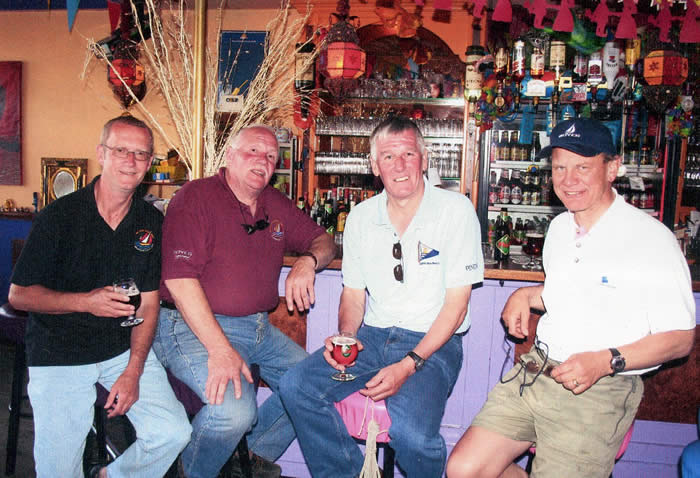|
North Sea Race 2003
: 23 July 2003 Strong winds were forecast for this year’s North Sea Race from Scarborough to Ijmoiden in Holland. This is an annual event organised by Scarborough Yacht Club with sponsorship provided, this year, by Boyes and Co., who have one of their stores in Malton.
I have wanted to do this race for years, but somehow I’d never quite got round to it. So, this year, I was very pleased to be invited to crew for the 30 foot yacht Trystar by her skipper, Harry Arrundale.
So, on the evening of Friday 18th July, Scarborough’s South Bay was crowded with yachts. The replica square rigged ship, the Grand Turk, sailed out of harbour, anchored, and prepared her guns to start the race. The view from the beech, as the yachts set off past the ship as the last gun was fired must have been breathtaking.
The North Sea has a reputation for being rough. This is because its depth is relatively shallow, and so stormy winds can whip the water up into a frenzy of dangerous short steep waves. However, at this time of year, the sea is usually calm, and sailors worry more about there being too little wind than too much of it. Too little wind often leads to a large number of boats having to retire. At the beginning, this year’s race was no different – in spite of the stronjg wind forecast! A light wind took us out of Scarborough Harbour, but this died later on in the evening, and, by late Saturday afternoon, we in Trystar had only completed a third of the crossing, and there was no way we were going to finish the race under sail within the time allowed. So we retired and turned on the motor.
Weather conditions were not the same everywhere. In another part of the North Sea that afternoon, another yacht, Little Jeannie, had been motoring for some time, with her mainsail still hoisted to balance the boat. All of a sudden she found herself in the middle of a storm, and hit by 40 knot winds. The sheer force of the blast was so powerful and unexpected that it almost knocked the boat over onto her side, and threw the crew who were not on duty out of their bunks
The storm didn’t reach us until Saturday night. I woke up to take over the watch with Norman Fowler, another of the crew (Some readers may know Norman under his stage name, Steve Cassidy). We looked out of the hatch, and could see the sky lit up by an electrical storm. Lightning flashed between the clouds, and bolts of lighting struck the sea. Strangely, the wind hardly increased, but the waves, driven by far away strong winds, were now about fifteen foot high. They lifted the yacht on their crests, and she crashed down into the troughs. The heavens opened, and the rain poured down. Sometimes, the the lightning struck the sea close by, and the glare was so bright and dazzling that for a few seconds it was impossible to see. Our skipper told us not to worry as the mast was properly earthed. It was not a comfortable ride.
By this time we were in the middle of the “Indefatigable” gas field. There seemed to be at least twenty gas production rigs in sight of each other – they looked like cites on stilts, with tower blocks with all their lights turned on. Each had its own guard ship, to make sure that no ship gets too close. One came close to us and checked our course. There are so many rigs that steering a straight course through and past all of them was like playing a game of bagatelle. The impression of the rigs with all their lights on, against the background of the continuous flashing of the lightning, while Trystar smashed her way through the waves, was spectacular.
By morning, the waves had subsided, and the sun came out. We were tired. We were not the only ones. There must have been a racing pidgeon event somewhere in England, because several ringed pidgeons landed on the boats, looking very weary – perhaps because they had had to fly through the storm. They flew away as soon as we saw land.
We had two pidgeons, but were not as lucky as the crew of Ayesha. Before the storm, they were visited by a school of dolphins, who played beside their yacht for at least twenty five minutes, leaping up and diving under the hull.
For most sailors, the race was the start of a holiday. We stayed one night in Ijmoiden, visited the cafes and bars of Amsterdam, carefully avoiding the muggers and the pushers, (who seem to ply their business openly in that city), and ended up sailing over the Ijselmeer to Hoorn. There we had our race dinner, and were entertained by the town’s choir, singing mainly English sea songs.
The winning yacht was Cordon Rouge from Hartlepool. It was a different kind of holiday. Most people would probably prefer to cross the sea in ferries, which are usually so steady that they are like huge floating hotels, but, for people who love the sea, an adventure sport like sailing provides challenges and stimulation, which are intrinsically worth while. Would I do it again? Definitely!


Skipper Jerry of LLamedos with crew in a bar in Holland after another successful North Sea Race |